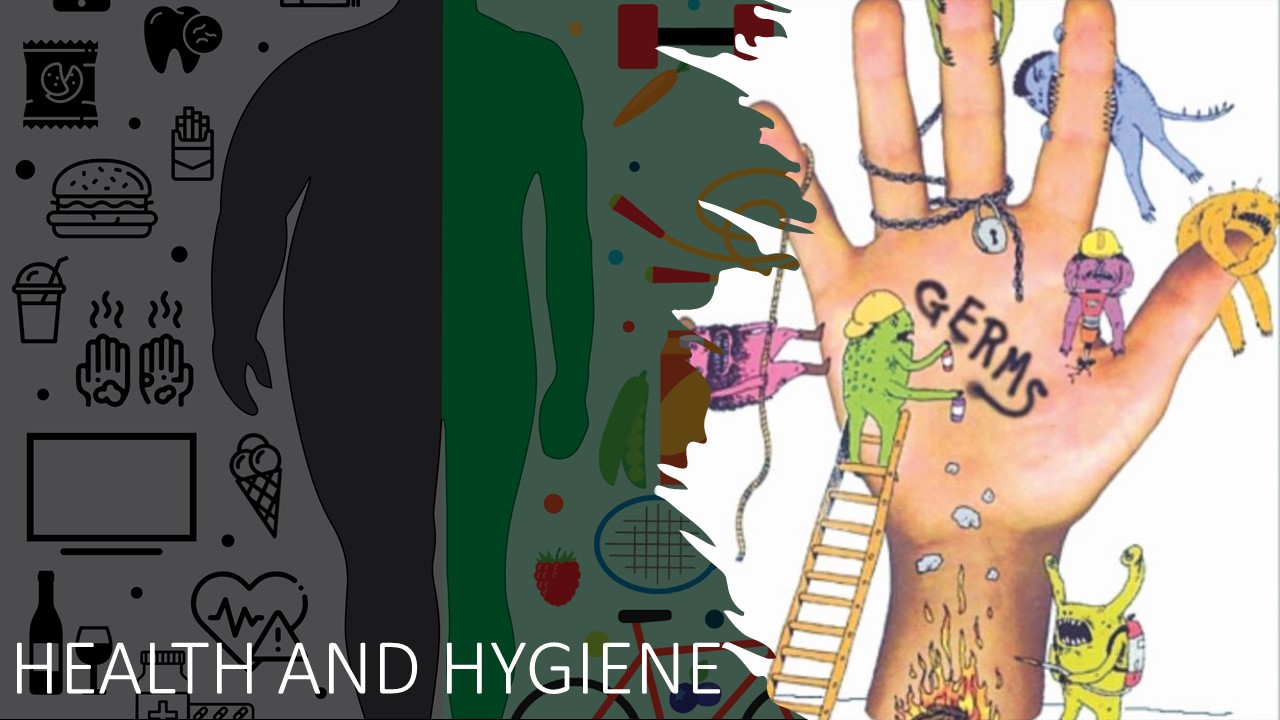Description
Diseases and its Types
The English word “health” comes from the Old English word hale, meaning “wholeness, being whole, sound or well,”.
Being healthy means the state of being in optimal mental and physical wellness.
It is a well-known fact that cell is the fundamental unit of living beings and there is constant activity in the cells and the organs in the body like beating action of the heart, filtering action of kidneys, breathing action of lungs, etc.
Anything that disrupts the normal functioning of these organs will lead to improper functioning of the body.
Disease disrupts the normal functioning of the body. It is the disorder of the body. It is characterized by specific signs and symptoms.
Personal hygiene:
It covers physical exercise, cleanliness, sleep, proper rest and other related practices such as keeping away from consuming alcohol, smoking, drugs etc. Many diseases can be prevented to a great extent just by maintaining good personal hygiene.
Social hygiene
The surrounding and other public places around us is our society. An individual’s mental and physical condition is greatly influenced by a good environment. Improper, unkempt and untidy surroundings and inappropriate ways of waste disposal in public places results in an unhealthy surrounding. Such practices cause an alarming growth of rodents, pathogens and other microbes and make us unwell. Consequently, both social and personal hygiene are vital aspects.
Disease
A disease causes us discomfort or an uneasy feeling, which may or may not necessarily give a pain sensation. Although “diseases-free” and “being healthy” are terms that are often correlated, they are completely different. Certain signs and symptoms are used to diagnose a particular disease.
What I will learn?
- (i) A brief introduction to maintaining good
- health and general idea of personal hygiene, public hygiene and sanitation.
- A brief introduction to communicable, non-communicable, endemic, epidemic, pandemic and sporadic diseases; modes of transmission. Meaning of each of the above with examples.
- Modes of transmission: air borne, water borne; vectors (housefly, mosquito, cockroach).
- Bacterial, Viral, Protozoan, Helminthic diseases:
- Bacterial: Cholera, typhoid, tuberculosis.
- Viral: AIDS, Chicken pox, Hepatitis.
- Protozoan: Malaria, Amoebic
- Dysentery, Sleeping sickness.
- Helminthic: Ascariasis, Taeniasis, Filiariasis. (symptoms and measures to control the above diseases.) (Scientific names of causative agents not required).
- Aids to Health: Active and passive immunity. Meaning of Active and passive immunity.
- An understanding of the use and action of the following – vaccination, immunization, antitoxin, serum, antiseptics, disinfectants, antibiotics. An idea of the local defense system and its merits, difference between antiseptics and disinfectants.
- Health Organisations: Red Cross, WHO. Major activities of the Red Cross and WHO.
Free
Free
Free access this course
-
LevelBeginner
-
Total Enrolled2
-
Duration4 hours
-
Last UpdatedSeptember 18, 2025
Hi, Welcome back!
Material Includes
- 🔥 Live Interactive classes with in-class doubt solving
- ⭐ Weekly Test and Quiz with instant tracking for progress
- ⚙️ Revision of the course after testing
- 👋 Fortnightly Parents and Tutor interactions
- 🌷 Expert monitoring of student's learning progress
- 👨👩👧👧 Daily communication over call, whatsapp and mail
- 💻3 hours on-demand video
- ✍4 downloadable resources
- ⌛Access for entire Academic Year
- 📱Access on mobile and Desktop
- 📋Assignments and review of the same
- 💡Tests and Correction by Board paper checkers
- 🏅Certificate of completion and Live tracking with Grade book
Course Duration:
4h
Course level:Beginner
Enrolled:2
About Course
In this section will learn the following chapters:
1.Diseases and its Types
2.Social hygiene
3.Disease
What I will learn?
- (i) A brief introduction to maintaining good
- health and general idea of personal hygiene, public hygiene and sanitation.
- A brief introduction to communicable, non-communicable, endemic, epidemic, pandemic and sporadic diseases; modes of transmission. Meaning of each of the above with examples.
- Modes of transmission: air borne, water borne; vectors (housefly, mosquito, cockroach).
- Bacterial, Viral, Protozoan, Helminthic diseases:
- Bacterial: Cholera, typhoid, tuberculosis.
- Viral: AIDS, Chicken pox, Hepatitis.
- Protozoan: Malaria, Amoebic
- Dysentery, Sleeping sickness.
- Helminthic: Ascariasis, Taeniasis, Filiariasis. (symptoms and measures to control the above diseases.) (Scientific names of causative agents not required).
- Aids to Health: Active and passive immunity. Meaning of Active and passive immunity.
- An understanding of the use and action of the following – vaccination, immunization, antitoxin, serum, antiseptics, disinfectants, antibiotics. An idea of the local defense system and its merits, difference between antiseptics and disinfectants.
- Health Organisations: Red Cross, WHO. Major activities of the Red Cross and WHO.
Course Curriculum
DISEASES
-
[PHYSICAL] [SNEH] HEALTH AND HYGIENE – DISEASES CARRIER
17:04 -
[PHYSICAL] [SNEH] HEALTH AND HYGIENE – RATS AND MOSQUITOS
15:55 -
[PHYSICAL] [SNEH] HEALTH AND HYGIENE – INTRODUCTION TO CHAPTER
11:03 -
[PHYSICAL] [SNEH] -INTRODUCTION
21:00 -
[PHYSICAL] [SNEH] – TYPES OF DISEASES
16:12 -
[PHYSICAL] [SNEH] – CAUSE AND CONTROL
21:10 -
[PPHYSICAL] [SNEH]- DISEASE AND FIRST AID
19:56
AIDS TO HEALTH
-
[PHYSICAL] [SNEH] HEALTH AND HYGIENE- HEALTH PART -I
19:12 -
[PHYSICAL] [SNEH] HEALTH AND HYGIENE – PART -II
20:06 -
[PHYSICAL] [SNEH] HEALTH AND HYGIENE – HEALTH ORGANISATION
11:50 -
[PHYSICAL] [SNEH] DISEASE – PART -I
21:07 -
[PHYSICAL] [SNEH]- DISEASES – PART -II
20:56 -
QUIZ – HEALTH ORGANISATION > COMMON HEALTH PROBLEMS IN INDIA
WASTE GENERATION AND MANAGEMENT
-
[PHYSICAL] [SNEH] HEALTH AND HYGIENE – WASTE GENERATION AND MANEGEMENT PART – I
17:43 -
[PHYSICAL] [SNEH] HEALTH AND HYGIENE – WASTE GENERATION AND MANEGEMENT PART – II
18:40 -
[PHYSICAL] [SNEH] WASTE GENERATION – PART -I
20:49 -
[PHYSICAL] [SNEH] WASTE MANAGEMENT
20:40
ADDITIONAL MATERIAL
-
[ONLINE] [KHOSHBOO] HEALTH AND HYGIENE – AN INTRODUCTION TO DISEASES AND WHY IT IS CAUSED
22:23 -
[ONLINE] [KHOSHBOO] HEALTH AND HYGIENE – DISEASE – COMMUNICABLE AND NON COMMUNICABLE DISEASES
02:25 -
[ONLINE] [KHOSHBOO] HEALTH AND HYGIENE – DISEASES CAUSED BY BACTERIA
05:00 -
[ONLINE] [KHOSHBOO] HEALTH AND HYGIENE – AIDS TO HEALTH – INTRO
06:00 -
[ONLINE] [KHOSHBOO] HEALTH AND HYGIENE – VACCINATION
04:00 -
[ONLINE] [KHOSHBOO] HEALTH AND HYGIENE – IMMUNITY
06:00 -
[ONLINE] [KHOSHBOO] HEALTH AND HYGIENE – AIDS TO HEALTH – HEALTH ORGANIZATIONS
04:00 -
[ONLINE] [KHOSHBOO] HEALTH AND HYGIENE – AN INTRODUCTION TO DISEASES AND WHY IT IS CAUSED
22:23
ASSIGNMENT AND DUE DATES
Student Ratings & Reviews

No Review Yet


